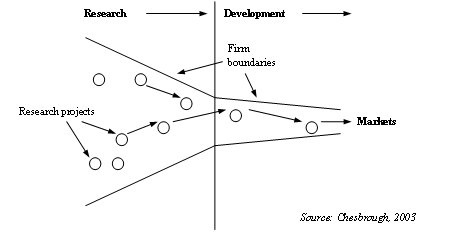博文
What is Open Innovation?
||||
Recently, growing attention has been devoted to the concept of "Open Innovation", both in academia as well as in practice. Chesbrough, who coined the term "Open Innovation" describes in his book "Open Innovation: The New Imperative for Creating and Profiting from Technology" (2003) how companies have shifted from so-called closed innovation processes towards a more open way of innovating.
Traditionally, new business development processes and the marketing of new products took place within the firm boundaries (Figure 1).

Figure 1 Closed innovation
However, several factors have led to the erosion of closed innovation (Chesbrough, 2003). First of all, the mobility and availability of highly educated people has increased over the years. As a result, large amounts of knowledge exist outside the research laboratories of large companies. In addition to that, when employees change jobs, they take their knowledge with them, resulting in knowledge flows between firms. Second, the availability of venture capital has increased significantly recently, which makes it possible for good and promising ideas and technologies to be further developed outside the firm, for instance in the form entrepreneurial firms. Besides, the possibilities to further develop ideas and technologies outside the firm, for instance in the form of spin-offs or through licensing agreements, are growing. Finally, other companies in the supply chain, for instance suppliers, play an increasingly important role in the innovation process.
As a result, companies have started to look for other ways to increase the efficiency and effectiveness of their innovation processes. For instance through active search for new technologies and ideas outside of the firm, but also through cooperation with suppliers and competitors, in order to create customer value. Another important aspect is the further development or out-licensing of ideas and technologies that do not fit the strategy of the company. Consider, for example, ASML, which is a Philips spin-off.
Open Innovation can thus be described as: combining internal and external ideas as well as internal and external paths to market to advance the development of new technologies.

Figure 2 Open innovation
What does this mean?
In the first place, the shift described above means that companies have to become aware of the increasingly importance of open innovation. Not all good ideas are developed within the own company, and not all ideas should necessarily be further developed within the own firm's boundaries. The table below further illustrates this:
| Closed innovation principles | Open innovation principles |
| The smart people in the field work for us. | Not all the smart people in the field work for us. We need to work with smart people inside and outside the company. |
| To profit from R&D, we must discover it, develop it, and ship it ourselves. | External R&D can create significant value: internal R&D is needed to claim some portion of that value. |
| If we discover it ourselves, we will get it to the market first. | We don't have to originate the research to profit from it. |
| The company that gets an innovation to the market first will win. | Building a better business model is better than getting to the market first. |
| If we create the most and the best ideas in the industry, we will win. | If we make the best use of internal and external ideas, we will win. |
| We should control our IP, so that our competitors don't profit from our ideas. | We should profit from others' use of our IP, and we should buy others' IP whenever it advances our business model. |
This means that within the company a shift should take place in the way people look at the company and its environment. Involving other parties when developing new products and technologies can be of great added value. Think for instance about cooperation with other firms in your sector, suppliers, universities, and of course end-users.
The business model plays a crucial role in this is. After all, how and when external knowledge is required and used is to a large extent determined by the companies' business model which describes how value can be created from innovations and which elements have to be sourced internally or externally
Reference: Chesbrough, H. (2003), "Open Innovation: The New Imperative for Creating and Profiting from Technology", Harvard Business School Press.
https://m.sciencenet.cn/blog-421218-366221.html
上一篇: 中国自主创新的科技战略与政策理论前沿
下一篇:创新型人才的“捧杀”与“棒杀”